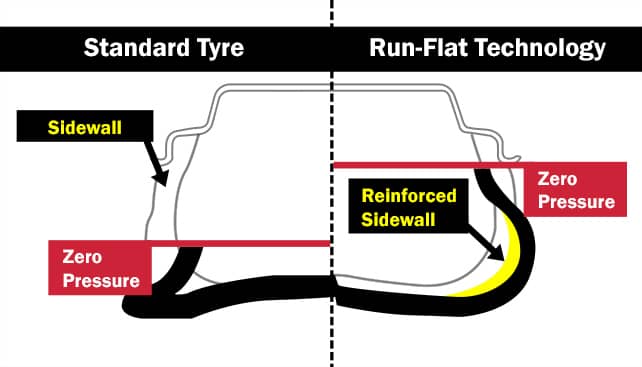Run Flat Tyres
Most tyre manufacturers now supply run flat tyres and some vehicle manufacturers choose to fit new cars with run flat tyres as original equipment. They are popular amongst manufacturers and motorists alike because they enhance safety on the road and help to reduce the risk of needing to change a tyre at the side of the road.
What is a Run Flat Tyre?
A run flat, or self-supporting, tyre is a tyre that has been constructed to enable the driver to continue driving for a short distance, maximum 50 miles, on a damaged tyre. This means that if you suffer a loss of air pressure or a puncture on the road, you would be able to drive home or to a nearby garage to have your tyre replaced. This eliminates the need to change your tyre at the side of the road. Vehicles fitted with run flat tyres do not have a spare tyre or a tyre repair kit.
Run Flat Tyre Technology

Constructed with much thicker sidewalls then regular tyres, a run flat tyre is strong enough to maintain the shape of the tyre for longer following a sudden loss of air pressure, usually caused by a puncture.
If a regular tyre loses pressure whilst driving, deflation occurs and the sidewall of the tyre will become separated from the rim of the wheel, making it difficult to control and dangerous to drive on.
Safety

As you can drive safely for a short distance on a puncture when using a run flat tyre, it is important that you pay attention to your tyre pressure monitoring system (TPMS) so that you are alerted if your tyre begins to lose pressure.
If you do suffer a puncture, you can keep driving on your run flat tyre for up to 50 miles but it is recommended that you maintain a slow speed of around 30mph wherever possible.
Unlike regular tyres, run flat tyres cannot be repaired once they have suffered a puncture. This is because when the tyre has been driven on following damage, the internal structure will have weakened and your safety would be compromised.
Switching to Run Flat Tyres
If you would like to fit run flat tyres to a vehicle that previously had conventional tyres fitted you must have a TPMS installed on your vehicle and you will need to change all tyres at the same time as you cannot mix conventional and run flat tyres.
As switching to run flat tyres may involve adjustments to your vehicle’s suspension, you should have them fitted by a tyre specialist.
Alternatively, if you wish to switch from run flat tyres to conventional tyres, this is permitted, however not recommended. It is important to remember to carry a puncture repair kit or a spare tyre if you do decide to remove your run flat tyres!
For further guidance on whether run flat tyres, a spare tyre or a tyre repair kit is best suited for you, take a look at our helpful guide.
Looking after Run Flat Tyres
Like regular tyres, you should maintain and look after run flat tyres to enhance your safety on the road. Every four weeks you should check tread depth, tyre pressure and tyre condition to ensure that they are safe.
For further information on run flat tyres simply contact your local Setyres branch where one of our tyre specialists will be happy to offer guidance.